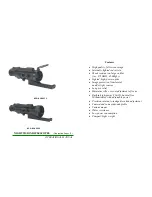
36
Browse:
Allows you to search the library for objects with certain parameters, much
like a search engine. "Edit Parameters" lets you set various parameters for the search,
such as: Object Type, Minimum Elevation, Largest,
etc. Once you have set the param-
eters of the search, select "Start Search" and press ENTER. Autostar II will display the
results of the search.
Event Menu
The Event menu provides access to dates and times of astronomical events. The
Event database includes:
Sunrise, Sun Transit,
and
Sunset:
Calculate the time of Sun rise, Sun transit, or Sun
set on the current date. Find rise and set times for other dates by entering a new date
into the “Setup: Date” menu.
Moonrise, Moon Transit,
and
Moonset:
Calculate the time of Moon rise, Moon tran-
sit, or Moon set on the current date. Find rise and set times for other dates by enter-
ing a new date into the “Setup: Date” menu.
Moon Phases:
Displays the date and time of the next Full, New, 1st Quarter, and 3rd
Quarter Moon.
Meteor Showers:
Provides information on upcoming meteor showers, such as the
Perseids, the Leonids,
etc. Also lists the dates of the showers and when they reach
maximum.
Note:
Meteors are fast moving objects that cover large areas of the sky and
are usually best observed with the naked eye.
Solar Eclipse:
Lists upcoming Solar Eclipses, including the date and type (total,
annular, or partial) of eclipse. Use the Scroll Up and Down keys to display the avail-
able data. This option is dependent on your location.
Lunar Eclipse:
Lists upcoming Lunar Eclipses, including the date and type (total, par-
tial, penumbral) of eclipse. Use the Scroll Up and Down keys to display the available data.
Min. (Minimum) of Algol:
Displays the minimum brightness of the dramatic eclipsing
binary star system, Algol. It is relatively close at a distance of 100 light years. Every
2.8 days during a 10-hour period, Algol undergoes a major change in apparent mag-
nitude as one of the two stars passes behind the other. The combined magnitude of
the two stars thus dips from +2.1 to a minimum of +3.4 halfway through the eclipse as
the second star is hidden. Autostar II calculates minimum magnitude time at mid-
eclipse.
Autumn
and
Vernal Equinox:
Calculate the time and date of the fall or spring equi-
nox of the current year.
Winter
and
Summer Solstice:
Calculate the time and date of the winter or summer
solstice of the current year.
Glossary Menu
The Glossary menu provides an alphabetical listing of definitions and descriptions for
common astronomical terms and Autostar II functions. Access directly through the
Glossary menu or through hypertext words embedded in Autostar II. A
hypertext word
is any word in [
brackets
], usually found when using the Autostar II Help function or
when reading a scrolling message such as a description of a planet or star. Press
ENTER whenever a hypertext word is on screen and Autostar II goes to the glossary
entry for that word.
To access directly from within the Glossary menu, use the Scroll keys to scroll through
the alphabet. Press ENTER on the desired letter. Scroll to the desired entry and then
press ENTER to read the description.
Utilities Menu
The Utilities menu provides access to several extra features within Autostar II, includ-
ing a countdown timer and an alarm. The Utilities functions include:
Balance OTA:
Use while you're balancing the OTA (see pages 22 - 23 for complete
procedure). Allows to balance on both axes.
Looking at or near the
Sun
will cause
irreversible
damage to your eye. Do not point this telescope at or near the
Sun. Do not look through the telescope as it is moving.
Summary of Contents for MAX-ACF
Page 59: ......
















































